
LinkedIn SEO: How to Optimize Your Account in 2025
In this article, learn about LinkedIn SEO and how it can help you get featured by the algorithm – no SEO expertise required.

Content Writer @ Buffer
Social media search is growing. Google search results are increasingly filled with results from social platforms. According to this study, 87 percent of social media marketers say social search is vital to their strategy.
There’s even an industry inside joke that adding “reddit” or “pinterest” or, of course, "linkedin" at the end of your search terms will more likely deliver exactly what you need.
LinkedIn is part of the charge – you’ll increasingly see LinkedIn pages interspersed with websites at the top of your search results. This is part of the platform's ever-evolving search engine optimization (SEO) capabilities.
So, in this article, we’ll share some insight into LinkedIn SEO and how it can help you get featured by the algorithm – no SEO expertise required.
What is LinkedIn SEO?
Like traditional SEO, LinkedIn SEO optimizes your personal or business page to rank higher in LinkedIn’s search results.
The primary objective of LinkedIn SEO is to enhance your visibility and make it easier for potential clients, partners, and followers to find you. This approach provides numerous benefits, including increased website traffic, targeted leads, and higher credibility.
However, LinkedIn SEO is no longer just for LinkedIn. You might have noticed that Google is increasingly ranking LinkedIn pages in its search results – just look at the results for the “how to build a career” search term.
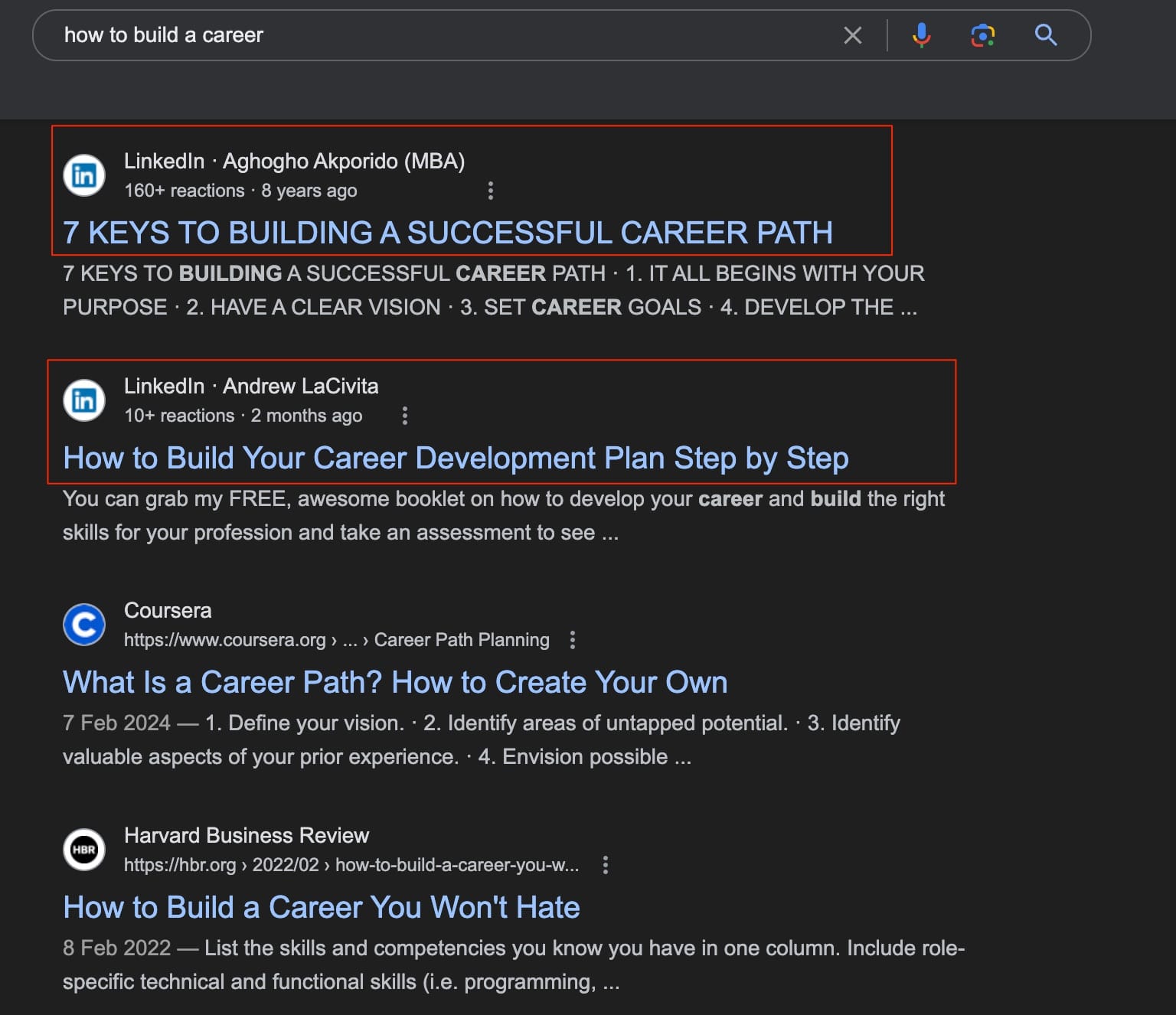
All the signs point to it: power users must adopt a more holistic LinkedIn SEO strategy when creating personal and business content.
Why is LinkedIn SEO important?
SEO gets you seen by your audience before competitors on Google. It’s not a stretch to say that the same philosophy applies to LinkedIn.
Optimizing your profile or company page helps you become more discoverable in searches within LinkedIn and external search engines. Here’s why that matters:
Enhances visibility and discoverability
A well-optimized profile or company page increases your chances of being found by potential employers, clients, or partners – there’s nothing more valuable than that on a professional networking platform. With relevant keywords in the headline, About section, and posts, your profile aligns with search queries from people actively seeking your expertise.
Builds credibility and trust
Profiles with optimized content convey professionalism and expertise, helping build trust among potential connections. Detailed and keyword-rich sections like Skills, Experience, and Recommendations enhance credibility, making people more likely to engage with your content or reach out for collaborations.
Increases engagement and networking
LinkedIn SEO attracts the right audience to your page, leading to higher-quality connections and meaningful engagement. Posting relevant content optimized with keywords ensures your updates appear in the feeds of those interested in your field, fostering genuine networking opportunities.
Aligns with business goals
For businesses, LinkedIn SEO aligns your page with marketing objectives. An optimized company page makes it easier for customers to find your services, increasing traffic and boosting lead generation. Posting SEO-driven content also positions your brand as an industry leader, reinforcing authority and trustworthiness.
Ranking factors for LinkedIn SEO
The LinkedIn search algorithm prioritizes content that aligns with the interests of specific audiences. Posts that hit the following points will be rewarded:
- Relevant to your experience and existing audience
- Specific to a niche or target audience
- Use appropriate keywords to maximize visibility
This rings true for me, with content on social media, remote work, career growth, and content marketing at the forefront of my feed.
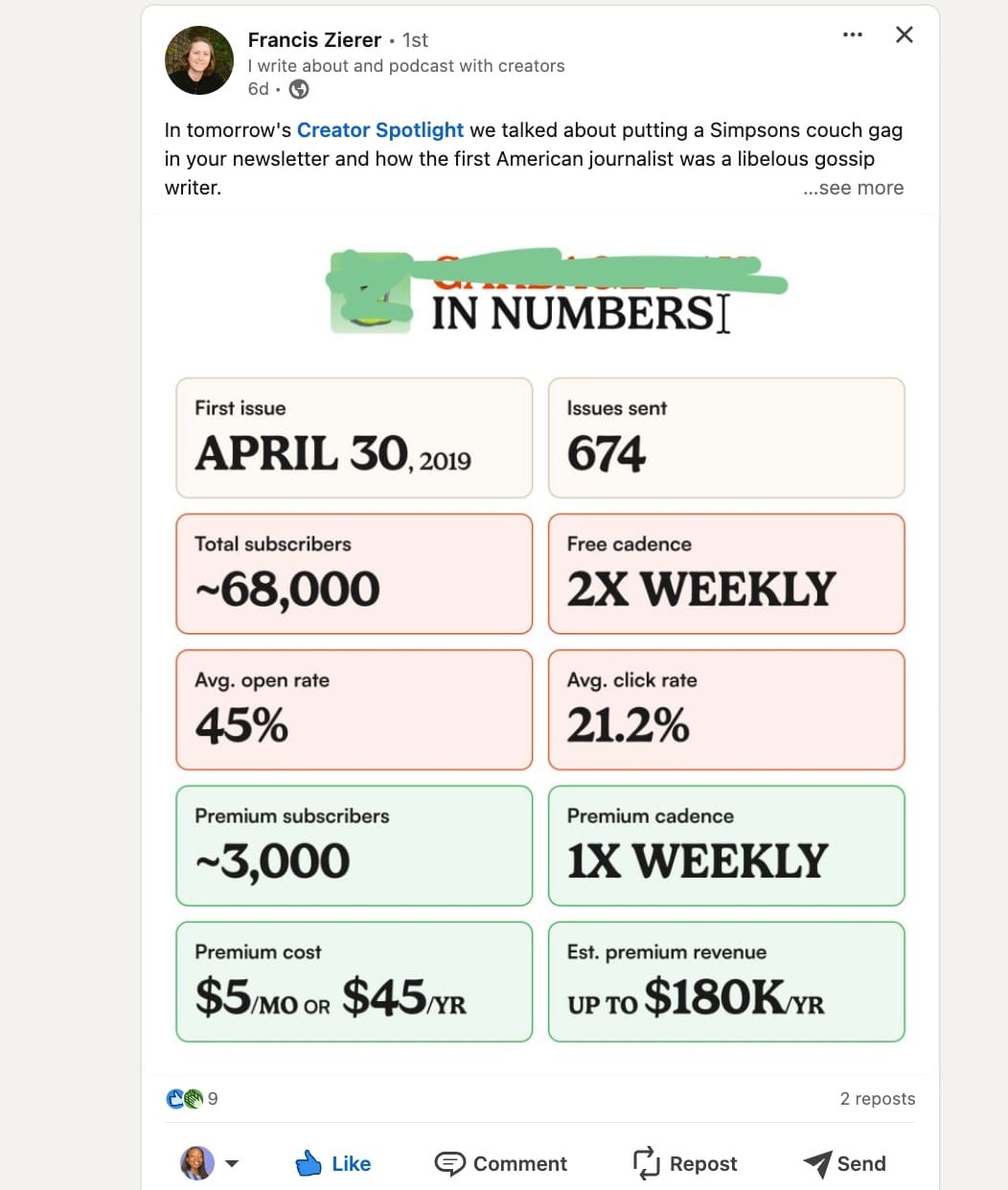
Content showcasing your industry authority ranks higher in the algorithm. This is both a good and a bad thing – if there’s something else you’d like to be known for, you have a lot more work ahead of you than if your content is centered around what you say your expertise is.
The basic rules remain the same regardless of what content you’d like to publish. If you share practical insights bolstered by your journey and offer real-world examples, you can establish yourself as a trusted expert. My top-performing posts from the past 90 days all fall within the niches I mentioned at the top of the section while staying true to my content style.
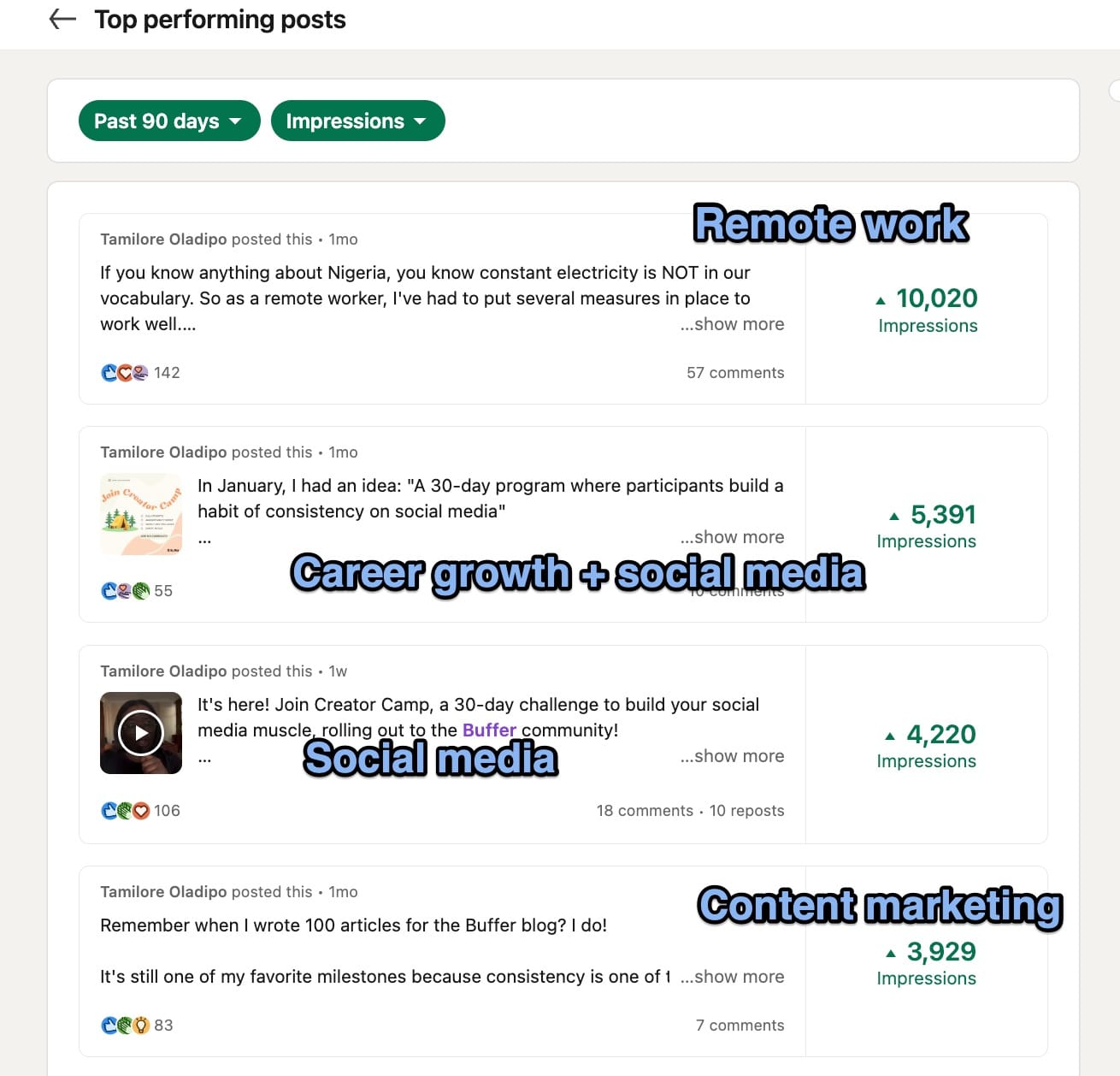
The algorithm favors posts that encourage genuine conversation and in-depth comments. So, create content that sparks meaningful interaction, such as asking questions, sharing unique perspectives, and inviting insights.
Finally, your followers and connections play a critical role in the reach of your content. Cultivate a network that values and engages with your posts while ensuring your connections receive value from the topics you cover.
LinkedIn SEO tips for personal accounts
When optimizing your personal LinkedIn profile, aligning your content with SEO best practices is important to increase visibility, credibility, and engagement. Here’s how to make the most of your presence:
Craft an SEO-friendly LinkedIn content strategy
Start by planning a content strategy that attracts and engages the right audience. Leverage LinkedIn’s features like long-form articles, videos, polls, and carousels to showcase your expertise:
- Create meaningful LinkedIn posts. The easiest answer to LinkedIn SEO growth is to share content. Long-form articles, short-form posts, and even a well-placed comment can give you visibility. Publish comprehensive articles addressing your audience's specific challenges and do your keyword research to improve visibility in LinkedIn and external searches. Even better, start a newsletter so you can put your content on a schedule and build an audience that expects and even looks forward to your content.
- Contribute to collaborative articles. LinkedIn’s AI-generated collaborative articles give users two benefits: the Community Top Voice badge and surefire visibility on the Feed for relevant topics. So, if you ever see a notification that “only you can answer,” get in there with valuable insights.

- Share videos, images, and carousels. Our data shows that videos are the top content format on LinkedIn, with images and carousels coming in a close second. Create visually appealing videos or carousel posts that provide practical advice or break down industry trends. Use descriptive titles and captions that incorporate the right keywords.
- Use polls to boost engagement: Polls are great for gauging audience interest in different topics, giving you an edge in developing relevant ideas.
Ensure every post is optimized with a compelling headline, a strong call to action that encourages comments or shares, and relevant hashtags that make your content more discoverable.
Focus on profile optimization
Your profile is often the first point of contact for anyone discovering your content, so make sure it accurately reflects your expertise and personal brand. Here's how to make those profile views count:
- Profile photo: I advocate showing personality, no matter the social media platform, but LinkedIn sets a very clear expectation of the profile picture you should have. Some folks will use a sketched version of themselves that matches the Notion branding for a bit more interest, like the Notion team, but a simple headshot will do in a pinch.
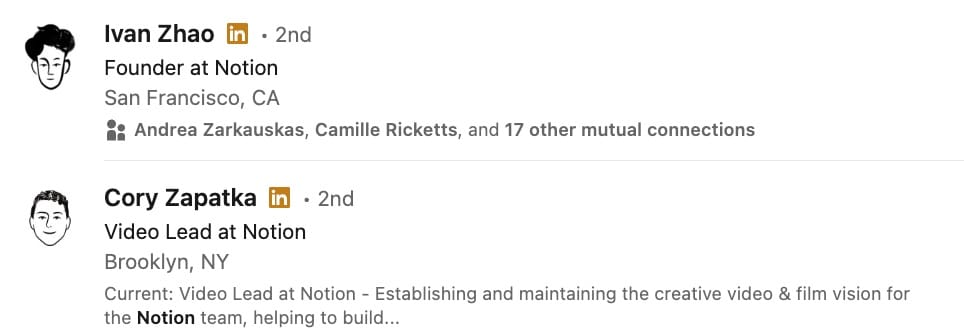
- Headline: Your headline should concisely convey your role, industry, and specialties. Use keywords that reflect your expertise, e.g., "Content Strategist | B2B Marketing Specialist." If you’re stuck, use the formula of “Job Title | Specialty | Important Project/Ethos”

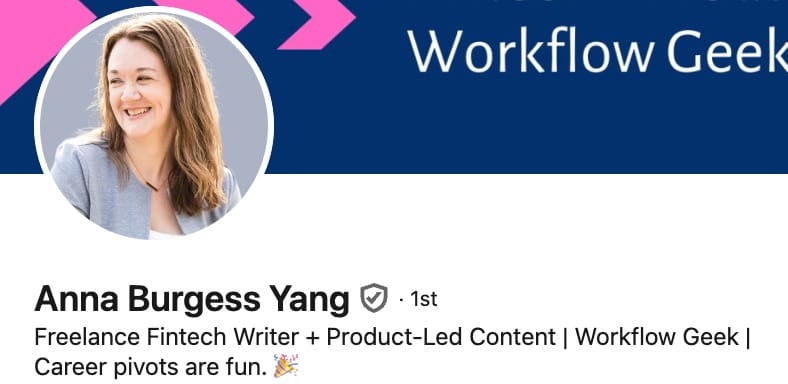
- Banner image: Create a cover photo that highlights your areas of expertise. Rather than going with a generic cover, include a call-to-action (CTA) or tagline on your background photo. You can include publications you’ve been featured in or impressive and relevant stats from your work.

- About Section: Weave your personal story into a concise narrative emphasizing your journey, values, and accomplishments. Incorporate industry-relevant keywords naturally and use bullet points for easy readability. It doesn't have any visible impact on your rankings in search, but it helps build a connection with new visitors to your profile.
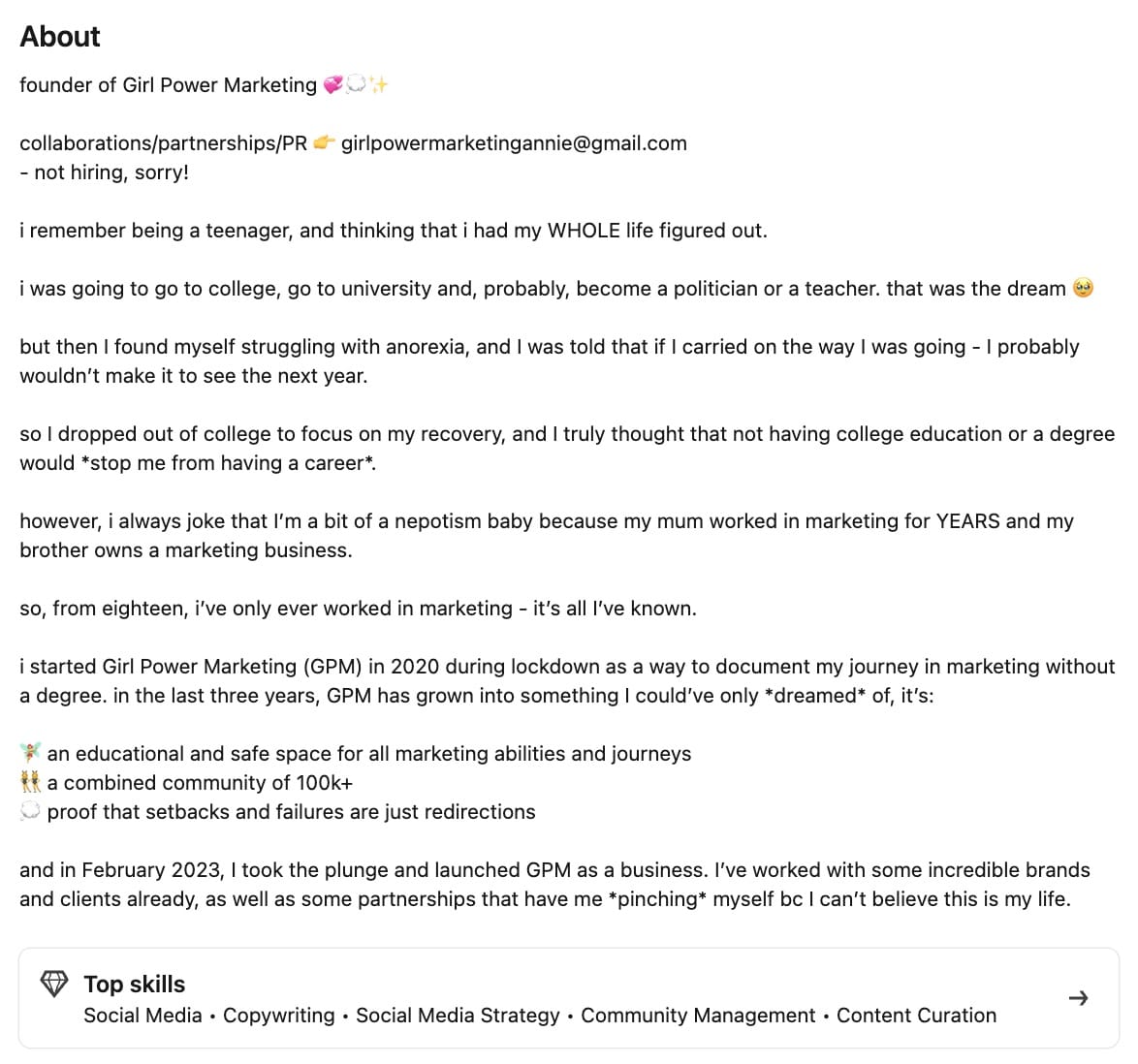
- Experience Section: Make sure to highlight what you did at each job you’ve included in your experience – but keep it natural and avoid keyword stuffing.
- Custom LinkedIn URL: Make it easy for people to find you by creating a custom URL like "linkedin.com/in/your-name." This also makes your profile memorable and shareable.
Ensure every section, including skills, certifications, and recommendations, is filled out thoroughly. Endorsements are especially valuable for building credibility and reinforcing your expertise, so ask your network for them.
Engage and connect with a quality network
Speaking of networks, LinkedIn isn’t the top networking platform for no reason. Its one-billion-strong user base is a lot of eyes that can be incredibly powerful for boosting LinkedIn SEO, but building a strong one requires a thoughtful approach. Treat your connections as a community to nurture professional relationships. Here's how:
- Thoughtful connections: Connect with people who align with your goals, whether they’re potential collaborators, recruiters, clients, or peers in your industry. Personalize your connection request with a brief message.
- Genuine engagement: Actively engage with posts from your network by sharing thoughtful comments or insights. Express gratitude when people engage with your content and share their posts to strengthen relationships.
- Join LinkedIn Groups: Participate in Groups that align with your industry or interests. Sharing expertise within these communities can help grow your influence and network.
These strategies can help you build a professional presence that stands out on LinkedIn and attracts opportunities aligned with your expertise.
LinkedIn SEO tips for Company Pages
LinkedIn company pages are a hub for your brand’s story, expertise, and credibility. With these tips, you can optimize and boost your page in the LinkedIn search rankings to attract your target audience, increase engagement, and reinforce your brand message.
Optimize your page
First impressions matter, so ensure your profile elements effectively communicate your brand's value.
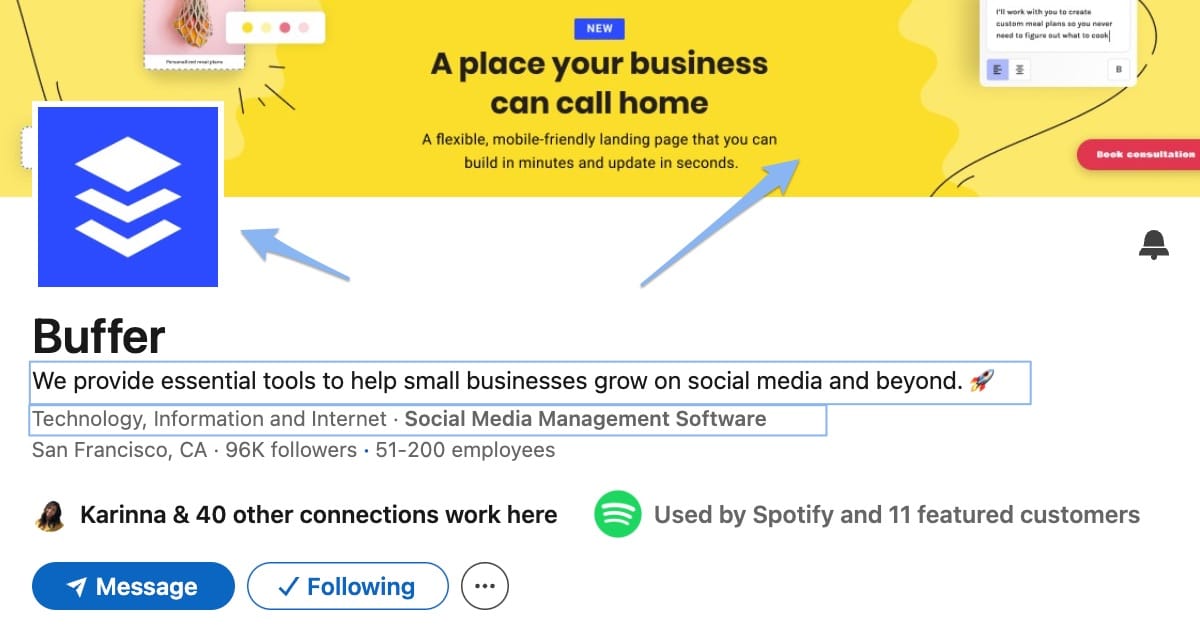
- Come up with a catchy but descriptive tagline: Craft a concise, keyword-rich tagline that acts as an elevator pitch. In just 156 characters, capture what your company stands for and whom it serves. For example, Buffer's "We provide essential tools to help small businesses grow on social media and beyond 🚀" firmly conveys our product and target audience.
- Refine your About section: Create a structured narrative highlighting your company's mission, values, and unique selling points. Incorporate relevant keywords like "social media management" or "small business" while ensuring the content is easy to read.
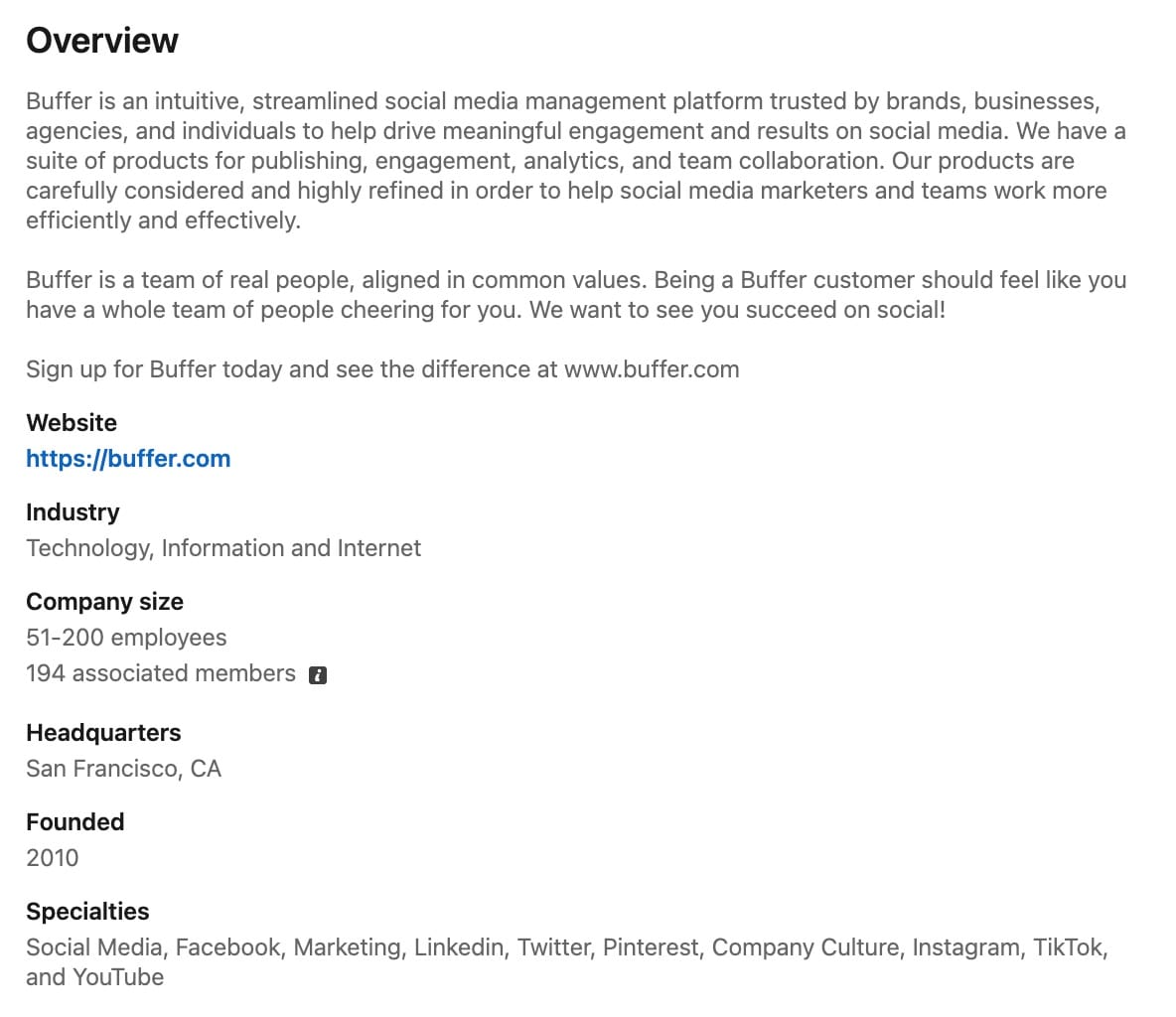
- Profile completeness: Every section should be fully filled out, including company size, specialties, location, and website URL. Link to your main website for seamless traffic, and provide detailed, engaging descriptions of your products and services. As the experts say, “Use every feature LinkedIn has made available.”
Finally, maintain a consistent brand voice and visual identity. Ensure your logo is high-quality, your banner aligns with your message, and your tone stays consistent across graphics, headlines, and storytelling.
Create and share SEO-driven content – powered by your employees
Your SEO content strategy should focus on establishing authority and engaging your target audience. LinkedIn articles appearing at the top of the Google search rankings is an unmissable opportunity for companies to take advantage of. However, “corporate” content on LinkedIn doesn’t go over too well with its audience.
You can still post regularly and diversify your content formats with articles, videos, and carousels. But growing your page to top-ranking status will take more than that.
That’s where employee advocacy comes in. When employees actively (and willingly) create and share content around the company's industry and amplify the brand's message, it leads to several significant benefits:
- Increased reach and visibility: Employee posts are often seen by their personal networks, which may include potential clients, partners, and recruits. This boosts the brand's organic reach, helping your company’s message reach a broader audience. It’s also important to note that the majority of the LinkedIn-native content that ranks on Google is from individuals – not companies.
- Increased trust and credibility: When employees create and share content within their circles, it builds trust. People are likelier to believe and engage with content shared by a familiar face rather than corporate posts.
- Thought leadership: Encouraging employees to share their expertise and industry insights establishes them as thought leaders. This adds a layer of authority to your brand, positioning the company as an innovative leader in the field.
- Employee engagement: Involving employees in the content strategy makes them feel more connected to the company’s mission and brand. This engagement can translate into higher productivity and retention.
Employee-shared content contributes to increased engagement signals on LinkedIn, which can improve how the company's page and posts rank in searches both on and off the platform. However, it has to be done willingly to feel genuine.
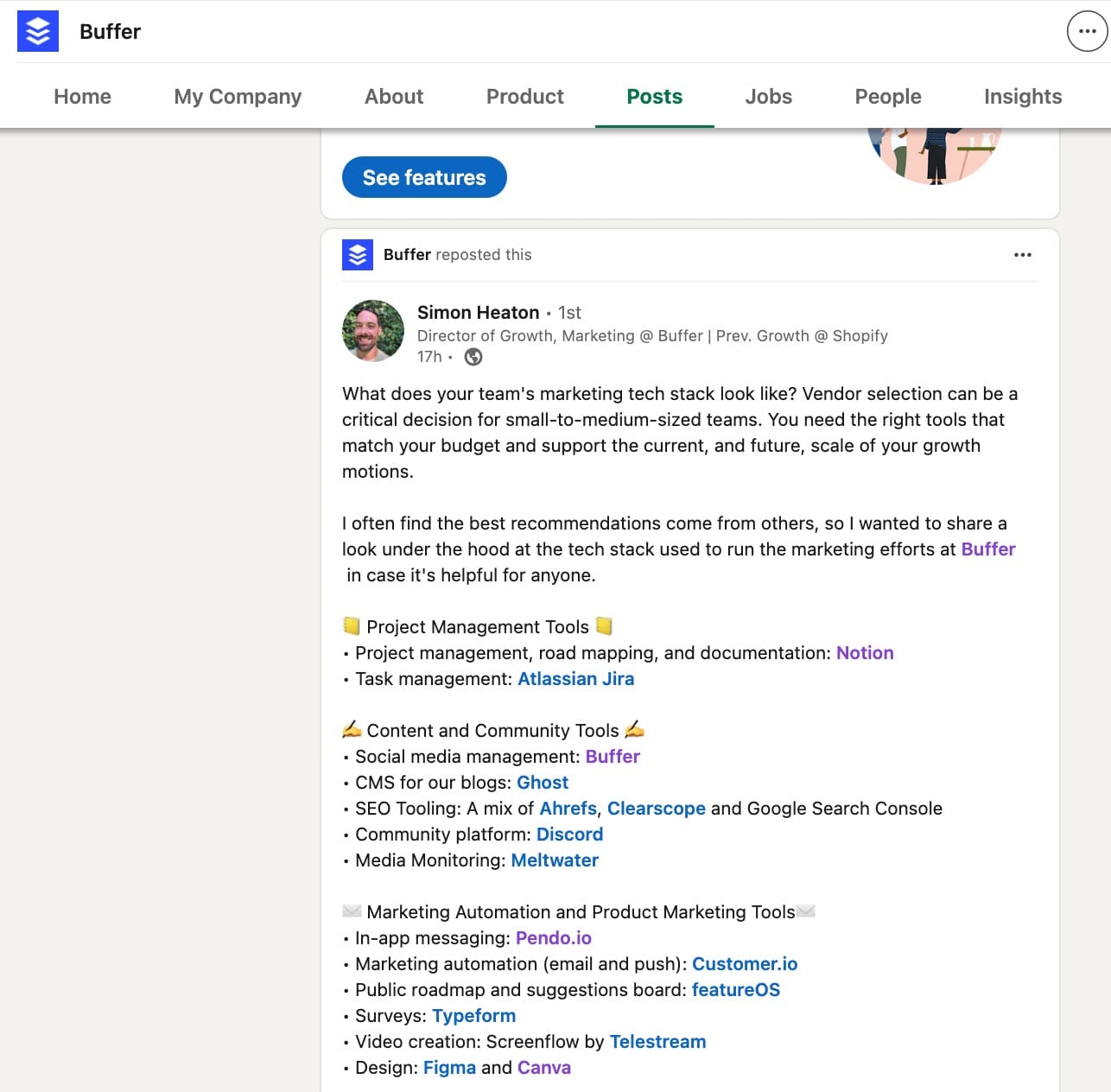
If you have employees open to publishing company content on their personal profiles, here are some tips to consider.
- Provide guidelines: Share best practices for LinkedIn posts, focusing on content that aligns with your brand message without stifling their personal brand voice.
- Offer training: Consider organizing workshops (or paying for existing ones) to help employees understand how their contributions boost the brand.
- Recognize and reward: Publicly recognize employees who actively contribute and consider incentivizing participation.
Employee advocacy is invaluable to the overall LinkedIn SEO strategy and should be integrated thoughtfully to maximize its impact.
You have an arsenal in your employees – encourage them to share their content, reshare company posts, and add personal insights in the comments. Highlight their stories to humanize your brand and strengthen the sense of community.
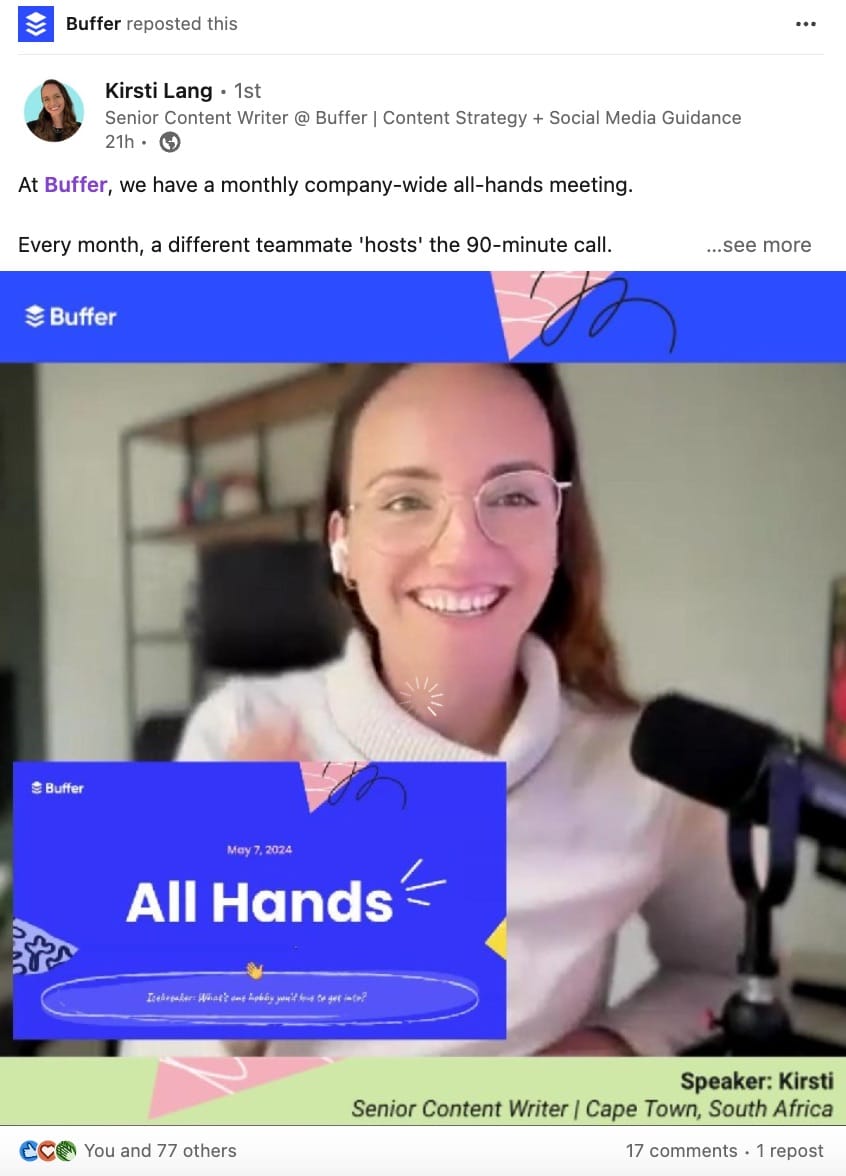
Monitor LinkedIn analytics regularly to identify high-performing posts and trends. Use these metrics and insights to refine your strategy, improve your content calendar, and amplify your impact through data-driven decisions.
Use LinkedIn to drive traffic to your chosen platform
LinkedIn has proven to be a powerful social network for professionals and companies. With these strategies, you can use LinkedIn to grow your brand's online presence and establish yourself as an authority in your industry, ultimately driving targeted traffic to your chosen platform.
Try Buffer for free
180,000+ creators, small businesses, and marketers use Buffer to grow their audiences every month.
Related Articles

TikTok just introduced Bulletin Boards, similar to Instagram's Broadcast Channels. Here's what you need to know.

We've reopened submissions for the new, cohort-based version of the Buffer Guest Post Program. Learn more in this article.
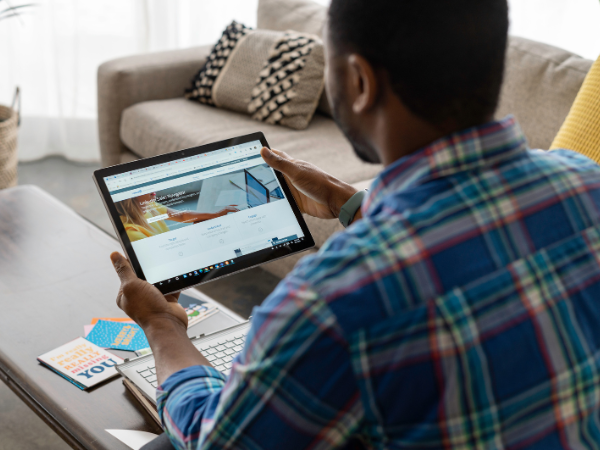
In this article, you'll find 20+ essential LinkedIn statistics that reveal the platform's reach, effectiveness, and continued growth.